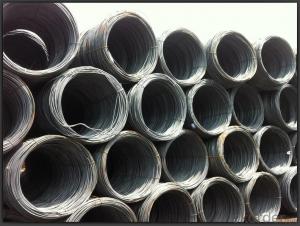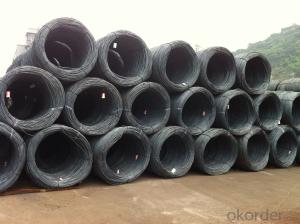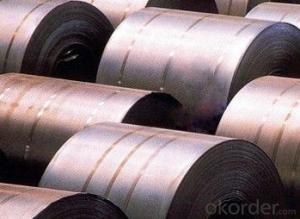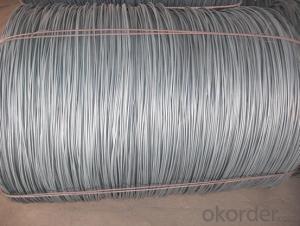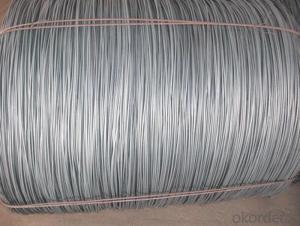Hot Rolled Steel Wire Rod SAE1006 5.5MM-14MM
- Loading Port:
- Tianjin
- Payment Terms:
- TT or LC
- Min Order Qty:
- 25 m.t.
- Supply Capability:
- 100000 m.t./month
OKorder Service Pledge
OKorder Financial Service
You Might Also Like
Product Description:
OKorder is offering high quality Hot Rolled Steel Wire Rod SAE1006 5.5MM-14MM at great prices with worldwide shipping. Our supplier is a world-class manufacturer of steel, with our products utilized the world over. OKorder annually supplies products to European, North American and Asian markets. We provide quotations within 24 hours of receiving an inquiry and guarantee competitive prices.
Product Applications:
After hot-rolled the products shaped into coil and delivery as finished product, including round, square, rectangular, hexagonal and so on. Since most of the products are round, it is generally called wire rod. Carbon steel wire rod is widely used in construction and manufacturing. Carbon steel wire rod is mainly used for reinforcement of reinforced concrete and welded structure or reprocessed (roberts , nail, etc.) materials, especially used to produce wire drawing, welding electrode, nails, spring, electronic, precise machinery parts and so on.
Product Advantages:
OKorder's Hot Rolled Steel Wire Rod SAE1006 5.5MM-14MMare durable, strong, and resist corrosion.
Main Product Features:
· Premium quality
· Prompt delivery & seaworthy packing (30 days after receiving deposit)
· Corrosion resistance
· Can be recycled and reused
· Mill test certification
· Professional Service
· Competitive pricing
Product Specifications:
Manufacture: Hot rolled
Grade: SAE1008 SAE 1006
Certificates: ISO, SGS, BV, CIQ
Diameter: 5.5mm, 6.5mm, 7mm,8mm,9mm,10mm,12mm,14mm, as per customer request
Packaging: Export packing, nude packing, bundled
Grade | Chemical Composition (%) | |||||
C | Mn | S | P | Si | B | |
SAE1008B | 0.10max | 0.32max | 0.045max | 0.040max | 0.30max | 0.0008min |
Mechanical properties | ||||||
Yield strength(N/mm2) | Tensile strength(N/mm2) | Elongation (%) | ||||
≥195 | 350-380 | ≥32 | ||||
FAQ:
Q1: Why buy Materials & Equipment from OKorder.com?
A1: All products offered byOKorder.com are carefully selected from China's most reliable manufacturing enterprises. Through its ISO certifications, OKorder.com adheres to the highest standards and a commitment to supply chain safety and customer satisfaction.
Q2: What makes stainless steel stainless?
A2: Stainless steel must contain at least 10.5 % chromium. It is this element that reacts with the oxygen in the air to form a complex chrome-oxide surface layer that is invisible but strong enough to prevent further oxygen from "staining" (rusting) the surface. Higher levels of chromium and the addition of other alloying elements such as nickel and molybdenum enhance this surface layer and improve the corrosion resistance of the stainless material.
Q3: Can stainless steel rust?
A3: Stainless does not "rust" as you think of regular steel rusting with a red oxide on the surface that flakes off. If you see red rust it is probably due to some iron particles that have contaminated the surface of the stainless steel and it is these iron particles that are rusting. Look at the source of the rusting and see if you can remove it from the surface.
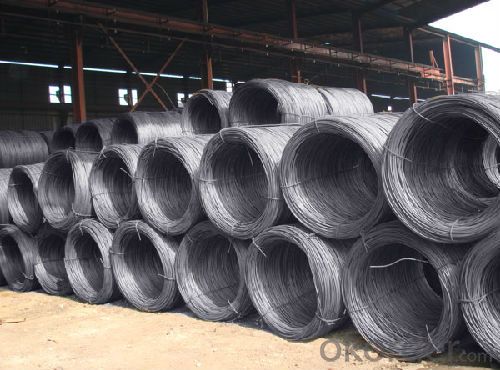
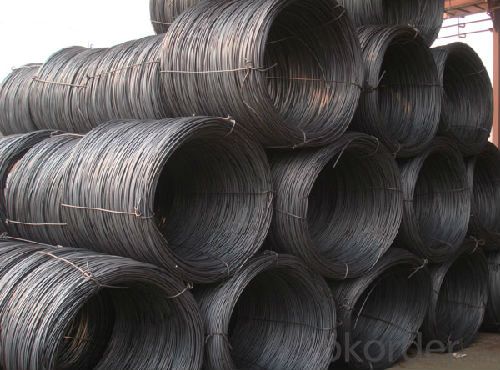
- Q:What are the main factors influencing the choice of steel wire rod order confirmation process?
- The selection of the order confirmation process for steel wire rod is influenced by various factors related to the business and industry. However, there are certain common factors that typically affect this decision: 1. Customer preferences: The specific requirements and preferences of customers are crucial in determining the order confirmation process. Some customers may prefer a streamlined and automated process, while others may require a personalized and manual approach. 2. Complexity of orders: The complexity of the steel wire rod order can also impact the choice of confirmation process. If the order involves multiple specifications, customizations, or special requirements, a more detailed and thorough confirmation process may be necessary for accuracy. 3. Order volume: The volume of orders received by the business can also influence the choice of confirmation process. For smaller order volumes, a simpler and less time-consuming process may suffice. Conversely, larger order volumes may require a more efficient and automated confirmation process to handle the increased workload. 4. Time sensitivity: The urgency or time sensitivity of the order is another factor to consider. If the order needs quick confirmation to meet tight deadlines, a streamlined and expedited confirmation process may be necessary. 5. Internal capabilities: The internal capabilities and resources of the business also play a role in determining the order confirmation process. If the business has advanced technology and systems in place, it may be able to implement a more automated and efficient confirmation process. Conversely, if resources are limited, a more manual and time-consuming process may be the only viable option. 6. Industry standards and regulations: Certain industries have specific standards and regulations that dictate the order confirmation process. Compliance with these standards is crucial, and the choice of confirmation process may need to align with industry requirements. 7. Risk management: The level of risk associated with the order can influence the choice of confirmation process. If there are potential risks or uncertainties involved, a more comprehensive and detailed confirmation process may be necessary to minimize errors or discrepancies. In conclusion, a careful evaluation of these factors is necessary to ensure an efficient, accurate, and customer-centric order processing in the steel wire rod industry.
- Q:What are the different shapes of steel wire rod?
- Steel wire rods come in various shapes, including round, square, hexagonal, and rectangular.
- Q:How is steel wire rod used in the production of wire ropes for ski lifts?
- Steel wire rod plays a crucial role in the production of wire ropes used in ski lifts. This raw material is carefully chosen for its specific properties, including strength, durability, and flexibility, to ensure the wire ropes can handle the heavy loads and constant usage associated with ski lift operations. Once the appropriate steel wire rod is acquired, it goes through a series of processes to transform it into wire ropes. The wire rod is initially cleaned and then heated to a specific temperature to enhance its malleability. It is then passed through various dies to gradually reduce its diameter and shape it into a continuous length of wire. Following this, the individual wires are twisted together to form strands. The configuration of this twisting process, known as stranding, can vary depending on the desired strength and flexibility of the wire rope. The strands are subsequently compacted and laid together around a central core, resulting in the final wire rope structure. The use of steel wire rod in the production of wire ropes for ski lifts offers several advantages. Firstly, steel is renowned for its high tensile strength, enabling the wire ropes to support heavy loads and provide a safe transportation system for skiers. Additionally, the durability of steel ensures that the wire ropes can withstand harsh weather conditions and extreme temperatures on mountain slopes. Furthermore, the flexibility of steel wire rod allows the wire ropes to bend and conform to the pulleys and sheaves used in ski lift systems, ensuring smooth and reliable operation. This flexibility is crucial in preventing sudden failures or damages to the wire ropes during continuous usage. In conclusion, the utilization of steel wire rod in the production of wire ropes for ski lifts is vital for ensuring the safety, reliability, and durability of these transportation systems. The properties of steel, such as its strength and flexibility, make it an ideal material for constructing wire ropes that can withstand the demanding conditions of ski lift operations.
- Q:Can steel wire rod be used in the production of springs?
- Yes, steel wire rod can be used in the production of springs. Steel wire rod is a commonly used material for making springs due to its high strength, durability, and flexibility. It can be easily shaped and formed into various spring designs, such as compression springs, extension springs, and torsion springs. The steel wire rod is typically processed through a series of manufacturing steps, including drawing, coiling, heat treatment, and surface finishing, to achieve the desired properties and specifications for the specific application of the spring. Overall, steel wire rod is an excellent choice for spring production due to its mechanical properties and suitability for various industrial and commercial applications.
- Q:What are the standard dimensional accuracy requirements for steel wire rod?
- The standard dimensional accuracy requirements for steel wire rod vary depending on the specific application and industry standards. However, there are generally accepted tolerances that are followed in the manufacturing and production of steel wire rod. In terms of diameter, the dimensional accuracy requirement typically ranges within a certain tolerance limit. For example, for a specific grade of steel wire rod, the diameter may be required to be within +/- 0.10 mm, meaning that the diameter can deviate by up to 0.10 mm from the specified value. This tolerance ensures consistency in size and allows for proper fit and function in various applications. Similarly, for the length of steel wire rod, a dimensional accuracy requirement is set to ensure uniformity and compatibility. The length tolerance may be specified as +/- a certain value, such as +/- 0.5% of the specified length. This tolerance ensures that the wire rod meets the desired length requirements and can be easily incorporated into different manufacturing processes. Additionally, other dimensional parameters such as straightness, surface finish, and ovality may also have specific requirements depending on the intended use of the steel wire rod. These requirements ensure that the wire rod can be efficiently processed, formed, and used in various applications while maintaining the desired quality and performance. It is important to note that the specific dimensional accuracy requirements for steel wire rod may vary depending on the industry standards, customer specifications, and the intended application. Therefore, it is crucial to consult the relevant standards or communicate with the appropriate stakeholders to determine the precise dimensional accuracy requirements for a particular steel wire rod.
- Q:How is steel wire rod used in the manufacturing of piano wires?
- Steel wire rod is used in the manufacturing of piano wires as it serves as the raw material for producing high-quality piano strings. The wire rod undergoes a series of processes such as drawing, annealing, and tempering to achieve the desired strength and elasticity required for piano strings. These strings are then used in the construction of pianos, ensuring that the instrument produces the desired sound quality and resonance.
- Q:What are the common production processes for meitnerium-coated steel wire rod?
- The common production processes for meitnerium-coated steel wire rod typically involve several steps. First, the steel wire rod is cleaned and prepared to remove any impurities or contaminants. Next, a thin layer of meitnerium is deposited onto the surface of the wire rod through a process called physical vapor deposition or chemical vapor deposition. This can be done in a controlled environment using specialized equipment. After the meitnerium coating is applied, the wire rod may undergo further treatments such as annealing or heat treatment to enhance its properties. Finally, the coated wire rod is inspected, tested, and packaged for distribution or further processing.
- Q:How is steel wire rod processed to achieve specific properties?
- Steel wire rod goes through a series of manufacturing steps to attain specific properties that make it appropriate for various applications. The process commences with the selection of premium raw materials, usually low carbon steel, which is melted in a furnace to create molten steel. Once the molten steel is formed, it is continuously cast into billets or blooms. These solidify and are then rolled into wire rod form through hot rolling. This hot rolling process involves passing the billets or blooms through a series of rollers to reduce their size and shape them into the desired wire rod dimensions. This step aids in aligning the grain structure of the steel, thereby enhancing its strength and ductility. Following hot rolling, the wire rod undergoes a cooling process to relieve any remaining stress and ensure dimensional stability. It is then subjected to a surface treatment, such as pickling or shot blasting, to eliminate any oxides or scale formed during hot rolling. In order to achieve specific mechanical properties, the wire rod may undergo further processing steps, such as cold drawing or heat treatment. Cold drawing involves pulling the wire rod through a series of dies to decrease its diameter, increase its tensile strength, and improve its surface finish. On the other hand, heat treatment involves subjecting the wire rod to controlled heating and cooling cycles to modify its microstructure, resulting in desired properties like hardness, toughness, or corrosion resistance. Moreover, the wire rod may undergo additional surface treatments, such as coating or galvanizing, to enhance its corrosion resistance or improve its aesthetic appearance. Coating can involve applying a layer of zinc, polymer, or other protective materials, while galvanizing entails immersing the wire rod in a bath of molten zinc to create a protective zinc coating. In summary, the processing of steel wire rod entails a combination of hot rolling, cooling, surface treatment, and potential further processing steps like cold drawing or heat treatment. These steps are meticulously carried out to achieve specific properties, such as strength, ductility, corrosion resistance, and surface finish, rendering the wire rod suitable for diverse applications in industries such as construction, automotive, manufacturing, and more.
- Q:What is a steel wire rod?
- The delivery of long wood is divided into two pieces: fixed gauge and coilYou refer to the wire rod, refers to the coil delivery of steel, under normal circumstances, according to commonly used, refers to the coil delivery of round steel, also known as smooth steel,
- Q:What are the different surface treatments for steel wire rod?
- Steel wire rods can undergo different surface treatments to enhance their properties and improve performance in various applications. Common surface treatments include: 1. Pickling: Wire rods are immersed in an acid solution to remove oxide scale or rust, resulting in a clean surface, improved corrosion resistance, and preparation for further treatments. 2. Phosphating: Through a chemical conversion process, a thin layer of phosphate coating forms on the wire rod surface. This coating enhances adhesion of subsequent coatings, improves corrosion resistance, and provides a better surface for painting or other finishes. 3. Galvanizing: Wire rods are coated with zinc, which acts as a sacrificial anode and offers excellent corrosion resistance. Galvanized steel wire rods are ideal for outdoor applications or environments with high humidity or exposure to corrosive elements. 4. Electroplating: Metal is deposited onto wire rods using an electric current, allowing for various coatings like nickel, chrome, or copper. These coatings offer improved corrosion resistance, enhanced aesthetics, and increased hardness or wear resistance. 5. Heat treatment: Controlled heating and cooling processes alter the microstructure and mechanical properties of wire rods. This treatment can enhance strength, toughness, hardness, or ductility, depending on the specific heat treatment process applied. 6. Coating: Wire rods can be coated with protective or functional coatings like epoxy, polyethylene, or PVC. These coatings provide additional corrosion resistance, insulation, or lubrication properties and can be applied through processes like hot-dip coating, electrostatic powder coating, or extrusion coating. Each of these surface treatments for steel wire rods offers unique benefits and is chosen based on the specific application's desired properties and requirements.
1. Manufacturer Overview |
|
|---|---|
| Location | |
| Year Established | |
| Annual Output Value | |
| Main Markets | |
| Company Certifications | |
2. Manufacturer Certificates |
|
|---|---|
| a) Certification Name | |
| Range | |
| Reference | |
| Validity Period | |
3. Manufacturer Capability |
|
|---|---|
| a)Trade Capacity | |
| Nearest Port | |
| Export Percentage | |
| No.of Employees in Trade Department | |
| Language Spoken: | |
| b)Factory Information | |
| Factory Size: | |
| No. of Production Lines | |
| Contract Manufacturing | |
| Product Price Range | |
Send your message to us
Hot Rolled Steel Wire Rod SAE1006 5.5MM-14MM
- Loading Port:
- Tianjin
- Payment Terms:
- TT or LC
- Min Order Qty:
- 25 m.t.
- Supply Capability:
- 100000 m.t./month
OKorder Service Pledge
OKorder Financial Service
Similar products
New products
Hot products
Hot Searches
Related keywords


